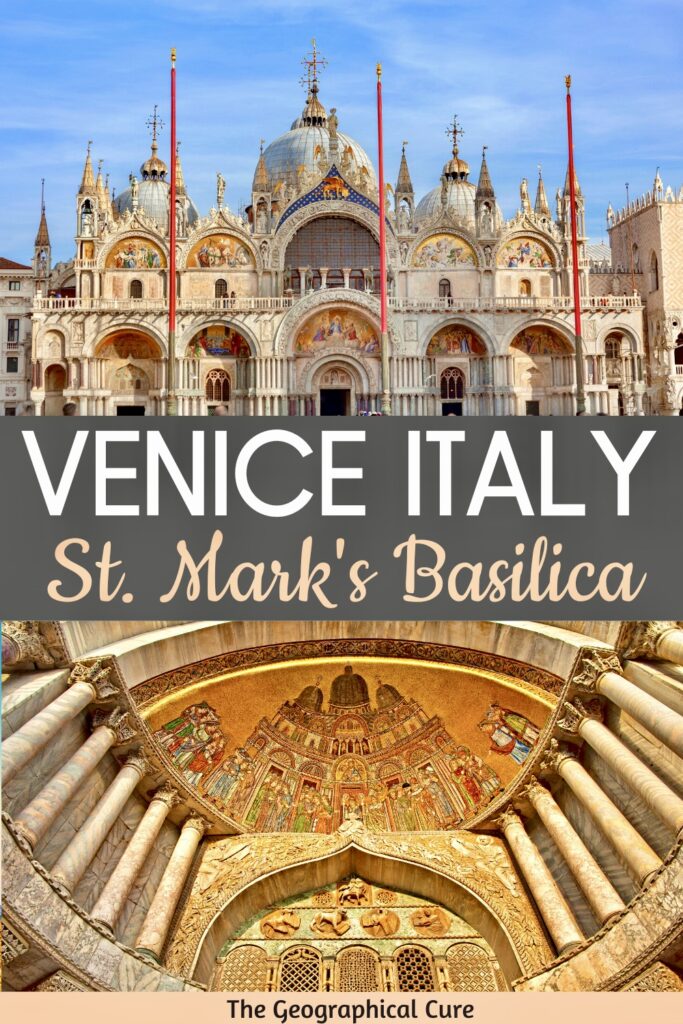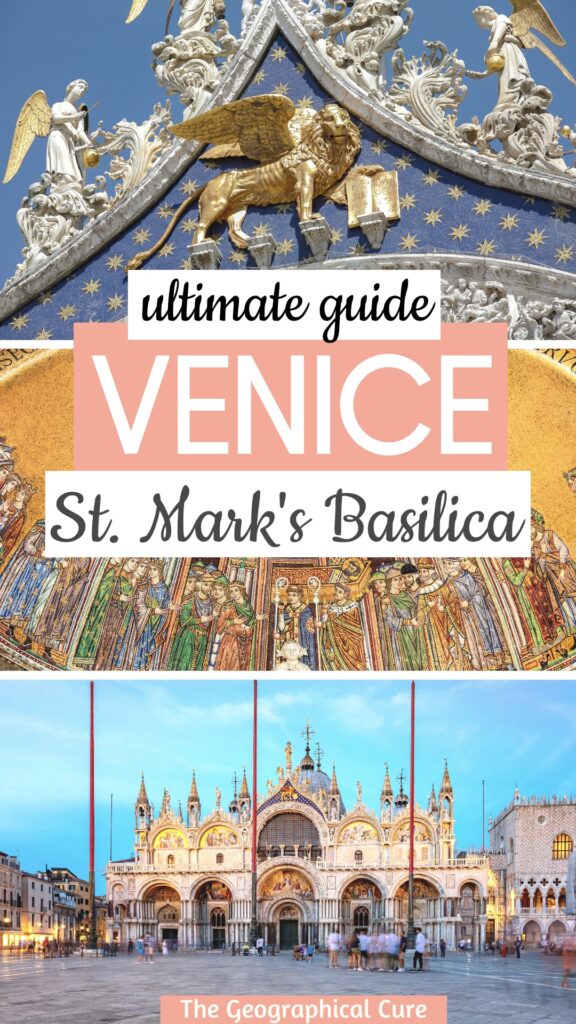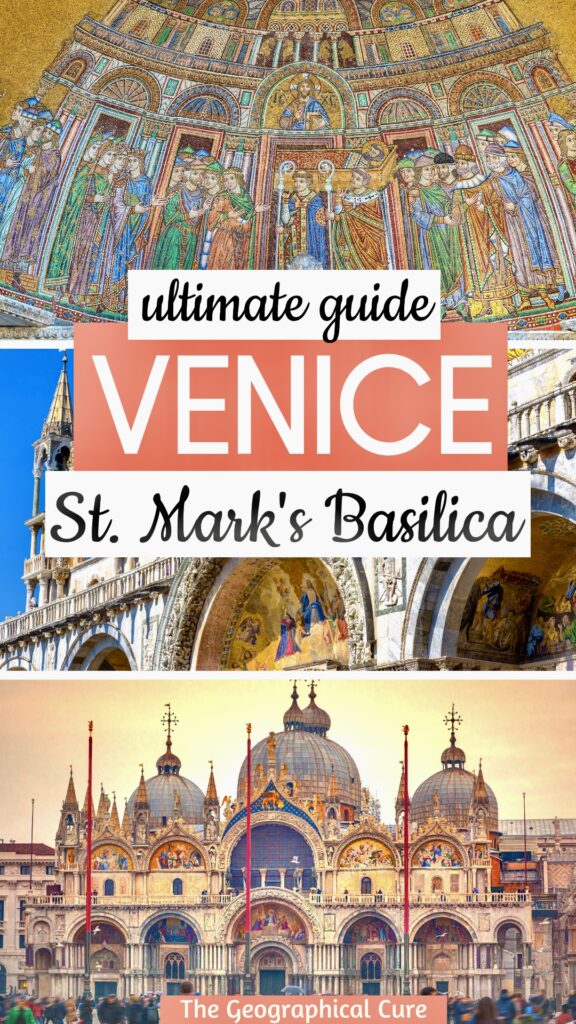St. Mark’s Cathedral is an awe-inspiring showcase of Italo-Byzantine architecture. This basilica’s story began with a purpose: to honor Saint Mark with a majestic home for his relics.
Inside, you’ll step into a dazzling mosaic wonderland, spanning a whopping 90,000 square feet. The church has a unique and eclectic mix of styles and materials.
Venice imported the art and architectural style from the Byzantine world. Just as Venice is like no other city in the Europe, St. Mark’s is like no other church in Europe.
In this St. Mark’s Basilica guide, I give you an overview of the basilica, tell you everything to see inside, and provide must know tips for visiting.
Here’s what you can see at a glance:
- opulent facade
- interior mosaics
- baptistery
- Zen Chapel
- rood screen
- Pala d’Oro
- tomb of St. Mark
- treasury
- Marciano Museum
- Balcony of the Horses
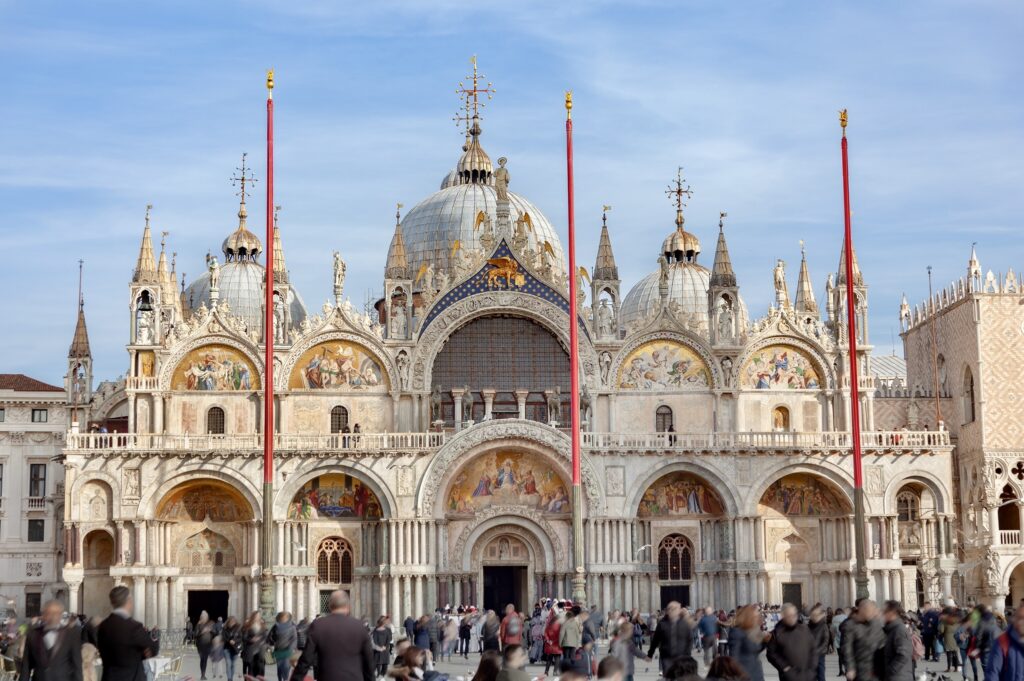
Tickets & Tours
If you’re thinking of visiting the basilica, it’s a good idea to plan ahead, especially during the peak season. Otherwise, you might end up feeling disappointed.
If you don’t have a timed entry ticket, you could find yourself waiting in line for 45-60 minutes, and you’ll still need to pass through security checks.
Check out these visiting options:
- skip the line fast track ticket
- skip the line ticket on Tiqets
- combination ticket that gives you entry to all attractions
- 3 hour tour with terraces
- 1.5 hour evening tour
- 1 hour guided tour
- St. Mark’s Basilica + Doge’s Palace tour
You can buy tickets on the basilica website, but it’s a bit confusing. I recommend getting tickets from a third party seller like Get Your Guide (linked above) or Tiqets instead. Admission is also included with the St. Mark’s City Pass, the Venice Pass, or the Venice Discovery Pass.
For a truly illuminating experience of St. Mark’s Basilica, I recommend opting for the evening tour. By day, the mosaics are harder to see in the dimly lit interior with daylight streaming in.
But as dusk descends, the basilica undergoes a transformation and is lit up. With better lighting, the interior comes alive, unveiling a whole new dimension to the resplendent mosaics. Plus, there are only a handful of people visiting at that time.
I’ve also enjoyed the terraces tour. The terraces provide a unique vantage point that offers breathtaking views of both the basilica’s architectural splendor and the surrounding beauty of Venice.
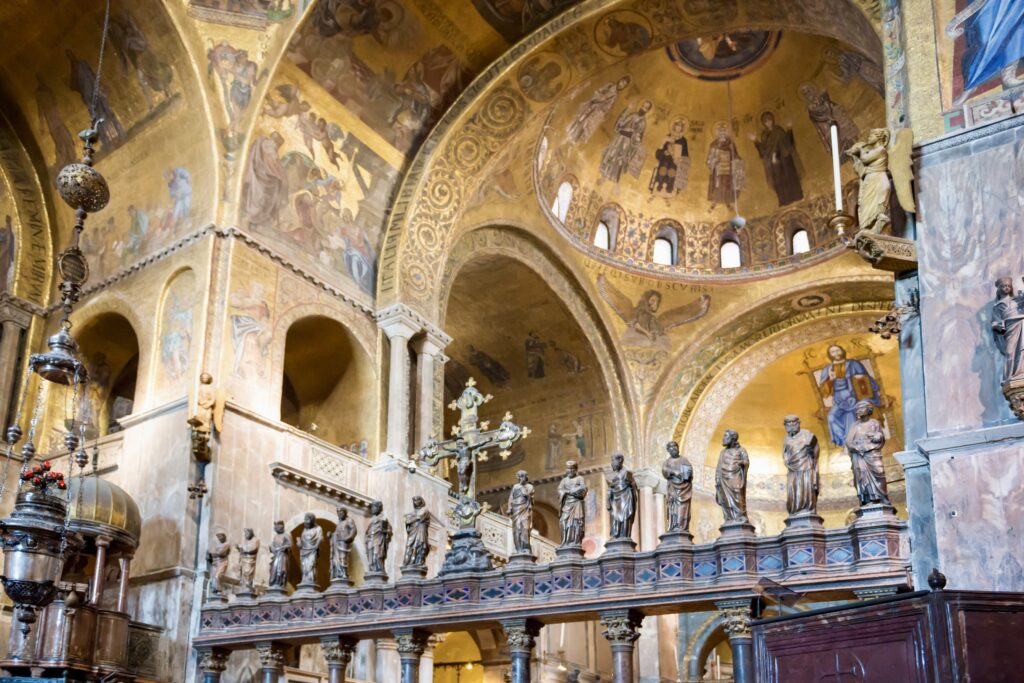
Mini History Of St. Mark’s Basilica
In the year 828, the very first version of St. Mark’s Basilica was erected. Its primary purpose was to serve as a sacred abode for the relics of Saint Mark the Evangelist.
In a daring feat in 828, two Venetian merchants secretly stole the saint’s remains from Alexandria. They embarked on a journey to Venice, cleverly disguising the precious cargo under a layer of pork.
To justify this audacious act, a legend gradually took shape. It recounted that Saint Mark’s relics were retrieved amidst a fierce lagoon storm. This fabricated tale legitimized Venice as the fitting final resting place for the saint.
As time marched on, the basilica underwent a series of renovations and expansions. Each contributed to its breathtaking grandeur.
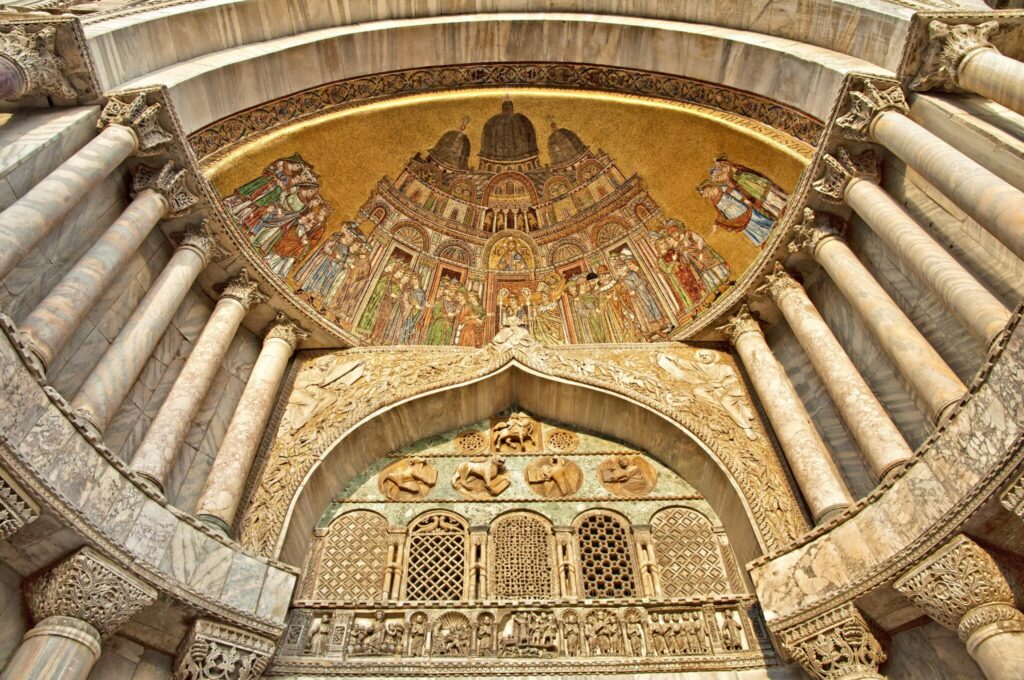
This iconic church in Venice held immense significance not only in spiritual matters but also in political realms.
Worshippers recognized that their allegiance was to the doge, not the pope, a testament to the intertwining of faith and governance. The basilica was even known as the Doge’s Chapel.
The place is no stranger to history’s twists – fires, earthquakes, floods, and preservation fights. The historic flood in 2019 caused much damage. Through it all, St. Mark’s Basilica stood tall, a symbol of Venice’s enduring spirit.
Today, it’s still weaving its spell with jaw-dropping architecture, mind-blowing art, and the whispers of an ancient past.
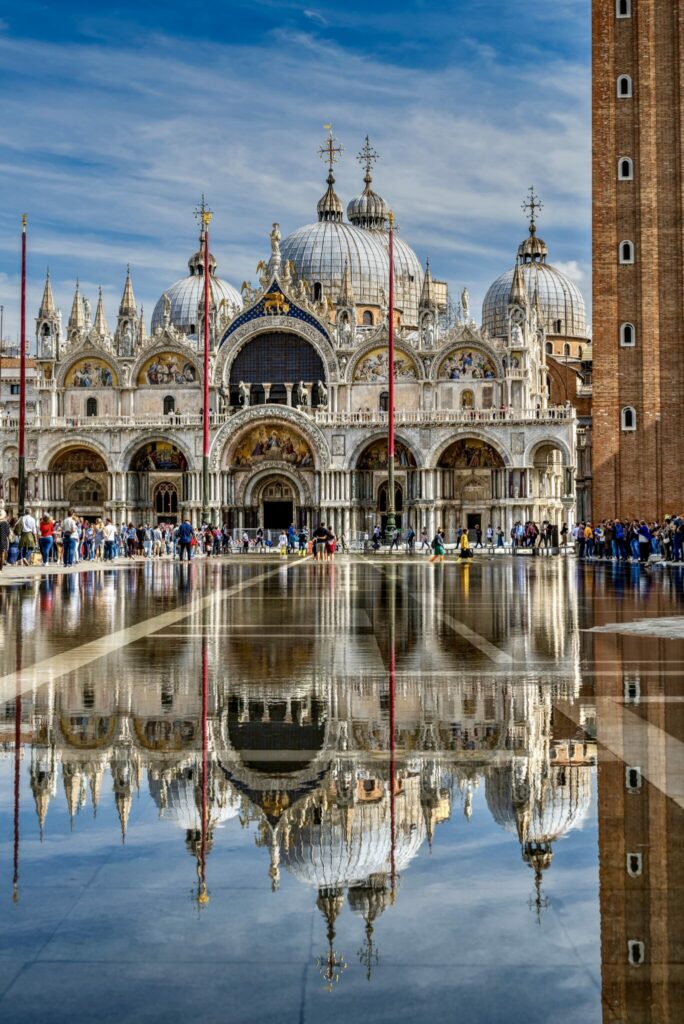
Guide To St. Mark’s Basilica: What To See
1. Facade
The basilica’s facade is the pinnacle of opulence. Your first view of it is eye popping. It’s an experience you won’t forget.
The main facade consists of two orders of five arches with clusters of columns in the lower order. The upper arches are topped by fantastic Gothic tracery. There are 500 columns.
Most of the mosaics on the facade are from the 17th and 18th centuries. The only original is the one over the northern most door. This depicts The Translation of the Body of St. Mark to the Basilica.
There’s also a mosaic on the southernmost door that memorializes the filching of the saint’s body.
The real treasures on show are the sculptures, particular those around the curved arches of the central portal. Sculptures on the upper order can be seen from the loggia.
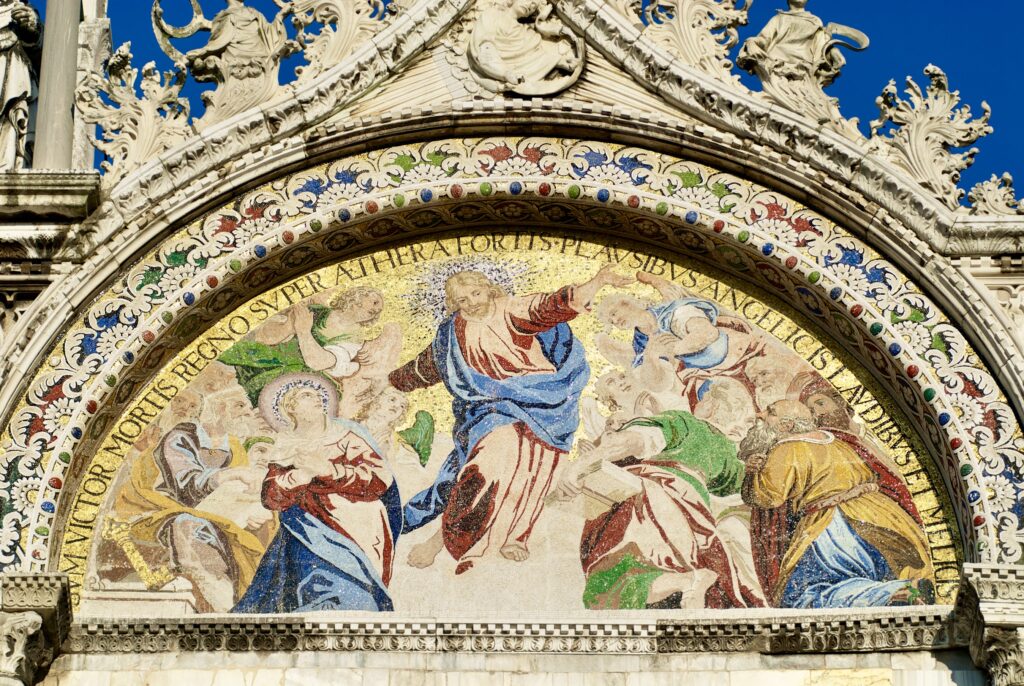
The covered porch, or narthex, has a beautiful marble floor. A small spot of porphyry marks the spot where Emperor Barbarossa paid homage to Pope Alexander III in 1177.
The south facade faces the Doge’s Palace and overlooks the sea. It greeted visitors arriving from sea.
To make the right impression, it’s decked out with richly encrusted trophies proclaiming the might of the Republic. There are two great arches and 60 columns.
At the corner stand the Tetrarchs. They’re a porphyry sculptural group of four kings from the 4th century. They most likely represent the Emperor Diocletian and his imperial colleagues.
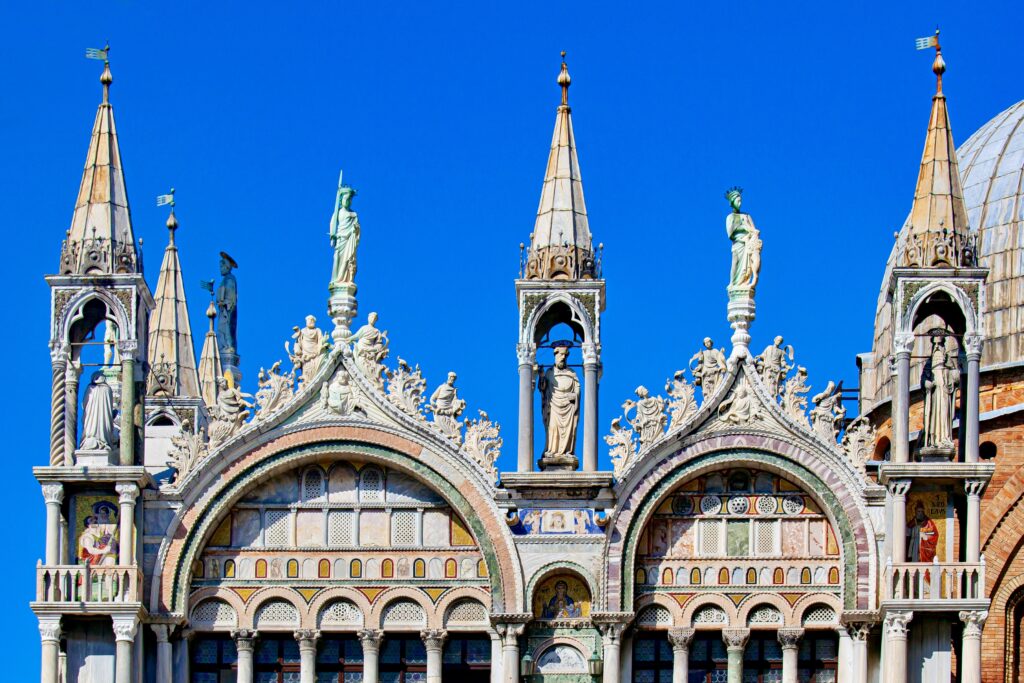
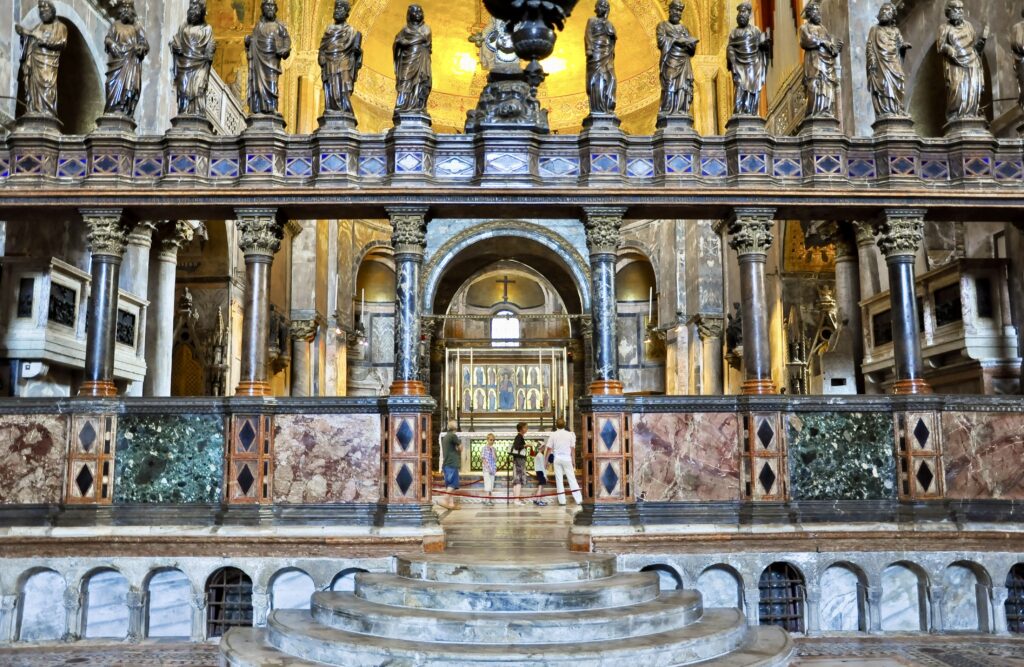
2. Interior
You enter via the Porta delle Carta, the main entrance to the basilica. The interior is a veritable cave of wonders. Even if it’s bursting with tourists, it still provokes wonder.
The basilica is a Greek cross design, with four arms of nearly equal length intersecting at a central dome. This architectural configuration symbolizes a harmonious blending of Eastern and Western influences, a hallmark of Venice’s cultural identity.
Elaborate Byzantine arches, intricate marble columns, and the five awe-inspiring domes create a sense of majesty and reverence.
The domes date back to the 11th century. There’s a central dome and four smaller domes, situated above each arm of the Greek cross plan.
There’s a fancy rood screen that separated the clergy and the regular folks. It’s a rare surviving antique oddity, marking the sacred zone.
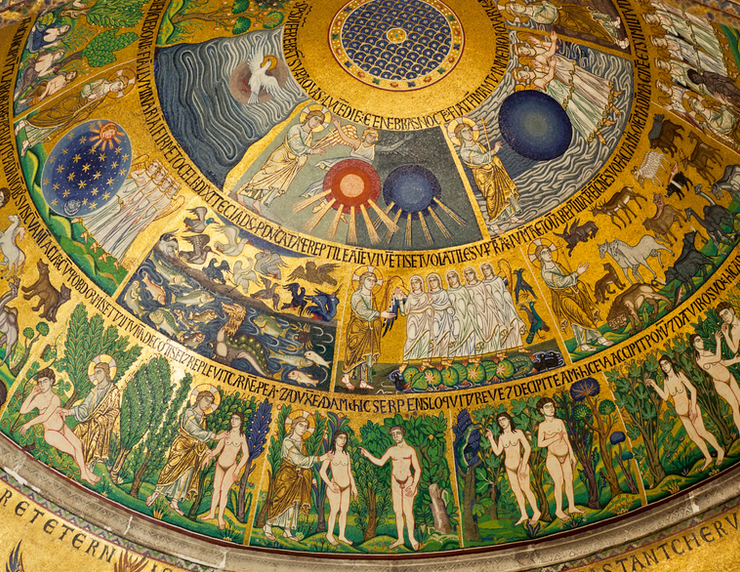
3. Golden Mosaics
The surfaces are entirely covered with a golden mosaic extravaganza that spans a whopping 85,000 square feet.
They’re made of real gold. Each mosaic is crafted by placing a delicate layer of gold leaf between layers of glass, resulting in these tiny glass tiles.
Back in the medieval times, Venice was a center of mosaic art in Italy – even giving Ravenna a run for its money.
The earliest mosaics date back to 1070. The finest pieces are from the 12th and 13th centuries. The chapels and the baptistery were decorated later in the 14th and 15th centuries.
In the central apse, the Christ Pantocrater mosaic is a 16th century copy of the Byzantine original. Beneath it, are the oldest mosaics in the church. They depict the four saint-protectors of Venice — Mark, Nicolas, Peter, and Hermagoras.
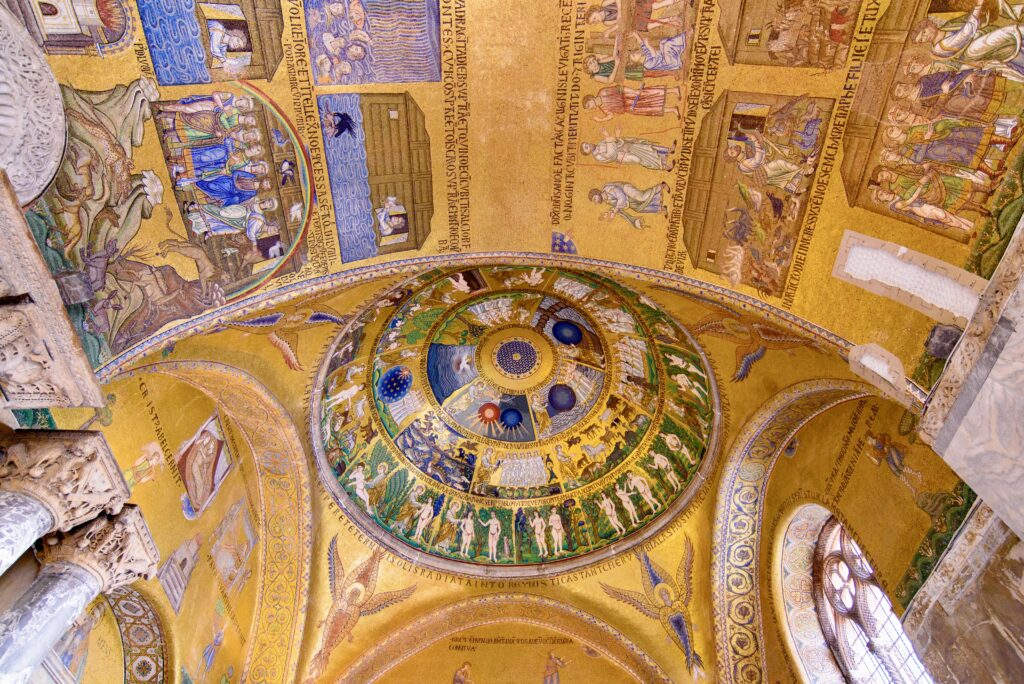
Surrounding the central dome are smaller domes and arches adorned with mosaics that narrate the lives of saints, apostles, and martyrs.
4. Baptistery and Zen Chapel
The baptistery contains the Gothic tomb of Doge Andrea Dandolo. There’s more interesting mosaics, especially one of Salome dancing.
In the adjoining Zen Chapel is the bronze 16th century tomb of Cardinal Zen.
Unfortunately, these two spots in the basilica aren’t open that often. They weren’t when I last visited.
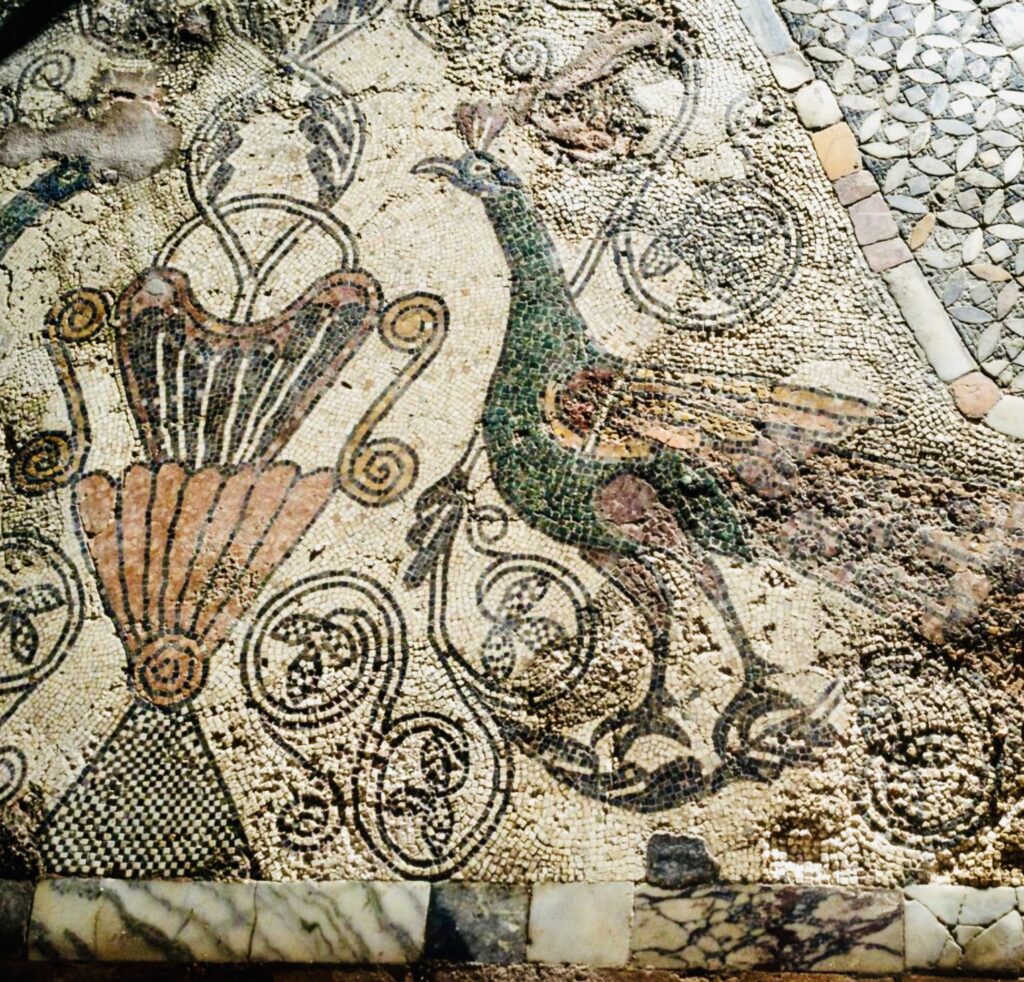
5. Floor
Don’t forget to look down! The basilica’s marble floor is a work of art itself.
It’s a mesmerizing mosaic of colors, patterns, and intricate designs that create a visually stunning and harmonious tapestry. It almost seems like an oriental rug.
Some of the patterns incorporate intricate labyrinthine designs, which are thought to symbolize the spiritual journey or pilgrimage. Other sections feature depictions of animals, mythological figures, and Christian symbols.
There’s some lovely mosaics of peacock couples, two in the left aisle and two in the right aisle.
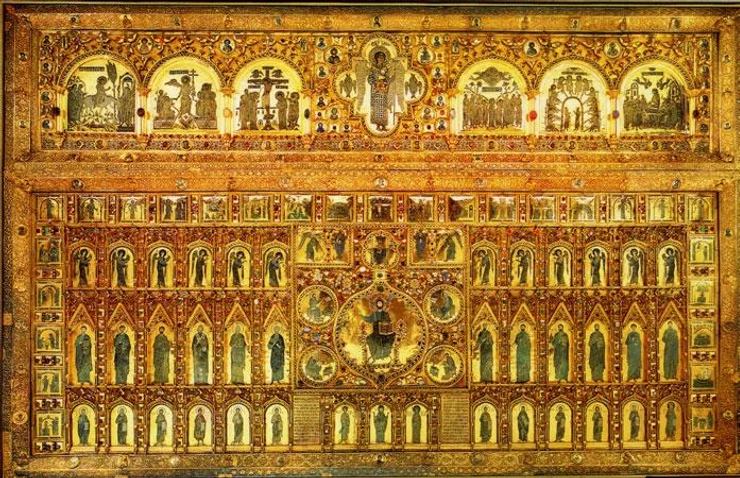
6. Rood Screen & Pala d’Oro
As I mentioned, the chancel is separated from the main body of the church by a red marble rood screen. It’s topped with fine statues of the Madonna, apostles, and St. George.
Behind the rood screen is the over-the-top Pala d’Oro, an elaborate Gothic altar panel on a pivot. It’s a Byzantine masterpiece that was made in Constantinople in 976. In later years, it was further adorned with rubies, pearls, emeralds, sapphires, and topaz.
In the center is image of Christ Pantocrater. Christ holds a Gospel book in one hand, representing his teachings, and raises his other hand in a gesture of blessing.
It’s worth it to cough up the extra cash to see the altar. It’s facing the back wall of the church, so otherwise you can’t see it. You pay inside near the Pala d’Oro entrance.
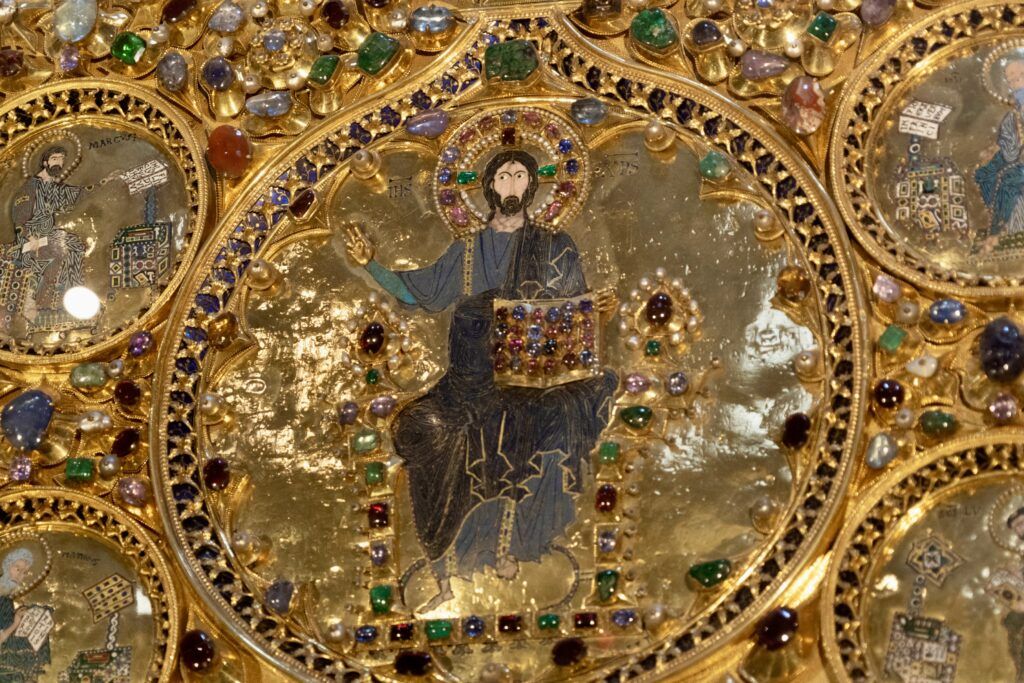
7. Tomb of St. Mark
The remains of St. Mark the Evangelist are located underneath the main altar of the basilica in the crypt.
The tomb itself is an elaborate and ornate structure, reflecting the reverence and importance attributed to the saint. The tomb’s exterior is adorned with intricate bronze and marble sculptures and ornamental details that pay homage to the saint’s life and legacy.
8. Treasury
If you need still more glitter, head into the treasury.
It contains horde of exquisite Byzantine gold and silver plunder from Constantinople — candelabras, vases, reliquaries, chalices. The highlights are two 11th century icons of Archangel Michael.
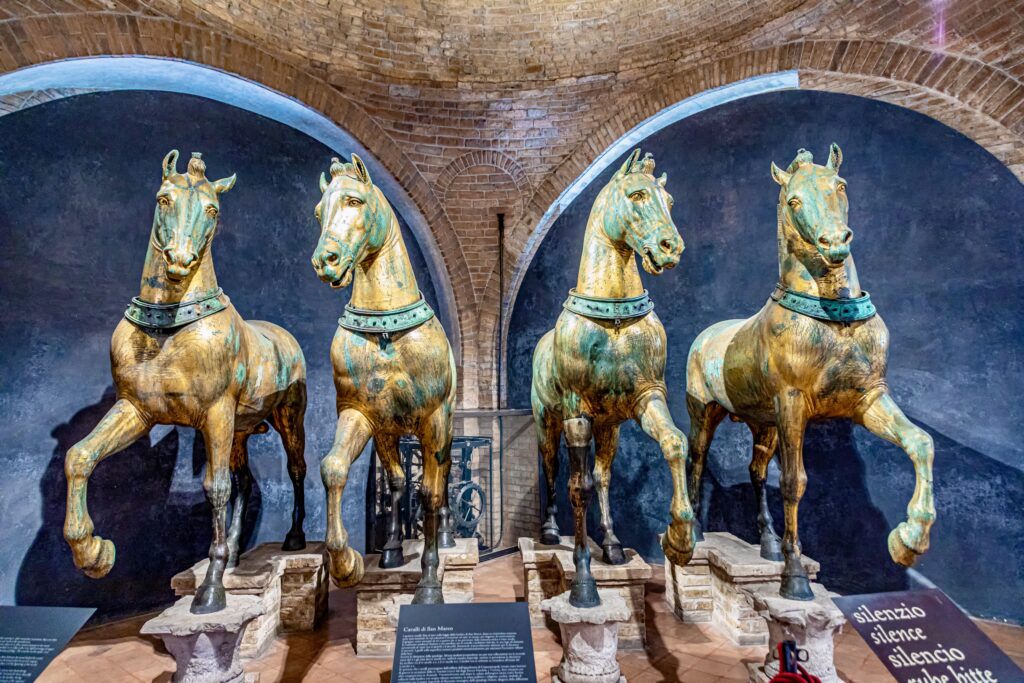
9. Marciano Museum
The Marciano Museum in the upper galleries holds a collection of invaluable artifacts that offer a multifaceted glimpse into the basilica’s rich history.
This treasure trove includes an array of religious relics, liturgical objects, and sacred vessels that once played a vital role in the basilica’s religious ceremonies.
Beyond religious artifacts, the museum houses sacred artworks, archaeological discoveries, and even historical documents that collectively enrich the basilica’s narrative.
The museum also houses the original quadriga. More on that just below.
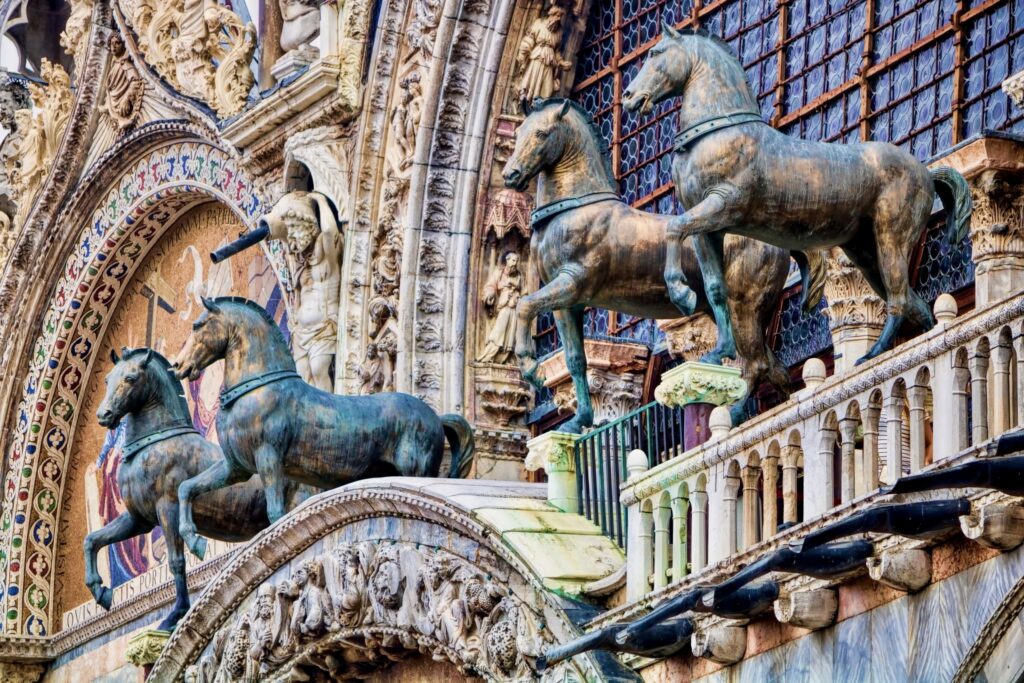
10. Loggia dei Cavalli
The Loggia dei Cavalli, or the Balcony of the Horses, stretches along the western and southern facades. This terrace boasts unbeatable views.
From here, you’ll be treated to a splendid panorama of St. Mark’s Square, alongside notable landmarks like the St. Mark’s Square, the bell tower, Torre dell’Orologio, the Doge’s Palace, and the Venetian lagoon.
Access to the terrace is via the museum, necessitating the €7 fee, even if museum exploration isn’t on your agenda. Of all the pay to play features of the church, though, this is most worthwhile.
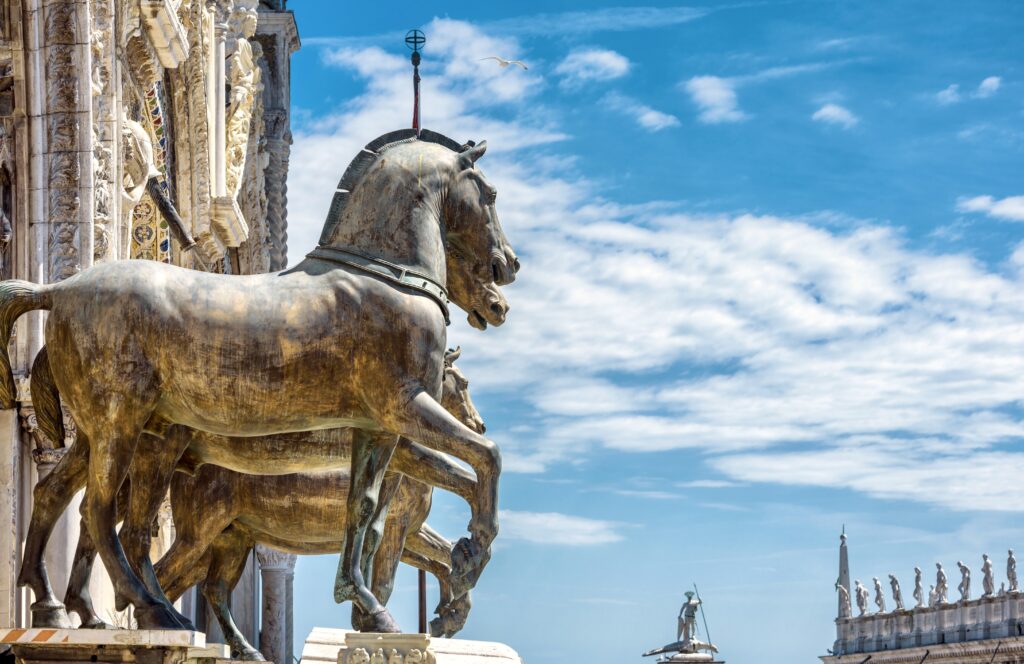
This is where the Triumphal Quadriga stands proud. They’re a quartet of exquisite bronze equines. These are copies. The originals were moved inside to preserve them.
Originally hailing from the Hippodrome of Constantinople (modern day Istanbul), the Quadriga was acquired by Venice as spoils of war in the 13th century.
It was at first thought the horses were Greek sculptures from the 4th century B.C. But now it’s thought they are Roman works from the 2nd century A.D.
Napoleon swiped the horses in 1797. They did not make their return to Venice until after Waterloo.
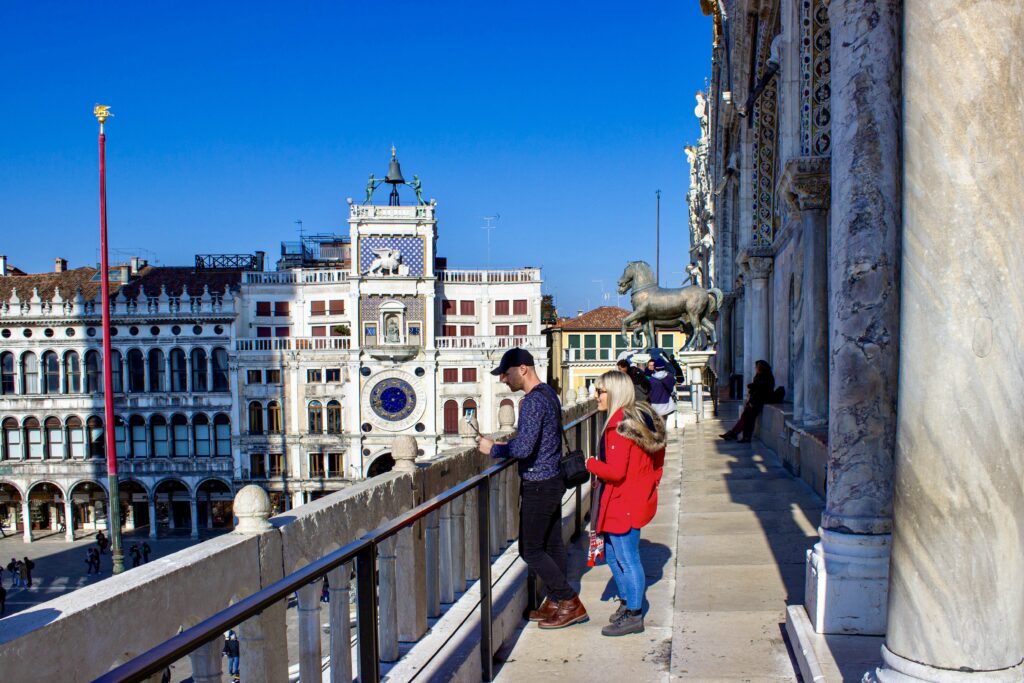
Practical Guide & Tips For Visiting St. Mark’s Basilica
Getting There: The closest water taxi/vaporetto stations are San Marco-San Zaccaria and San Marco Giardinetti. From both of these stations, it is a 4 minute walk to the basilica.
Hours: The basilica is open from 9:30 am to 5:15 pm. Last admission is at 4:45 pm.
Tickets:
The basilica costs € 3 to visit. You can book a skip the line ticket or skip the line tour in advance to avoid a wait.
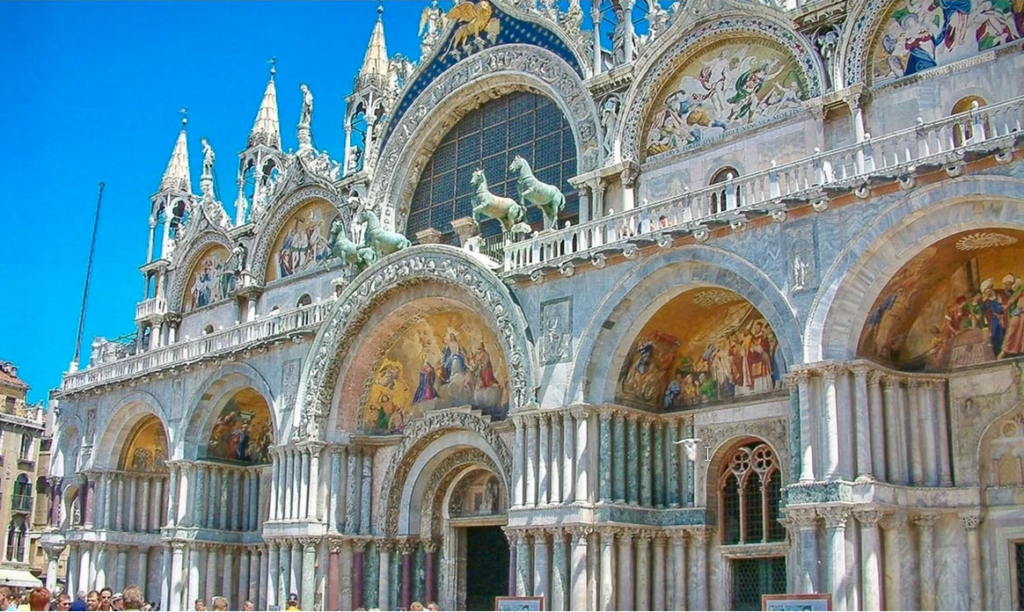
There are a few stops along the visitor walking path that you have to pay a few euros to visit:
- San Marco Museum: € 7
- Pala d’Oro: € 5 (pay inside the basilica)
- Bell tower: € 12 (click here to pre-book a ticket)
Even with the skip-the-line options, you’ll still find yourself in a queue for security checks.
This might lead to a brief 15-30 minute wait before you can enter the basilica. But it’s far better than waiting outside for an hour beforehand.
I’ve visited St. Mark’s several times now. My favorite visit was the after hours private tour. That doesn’t include the terraces though, so you may want to come back to do that.
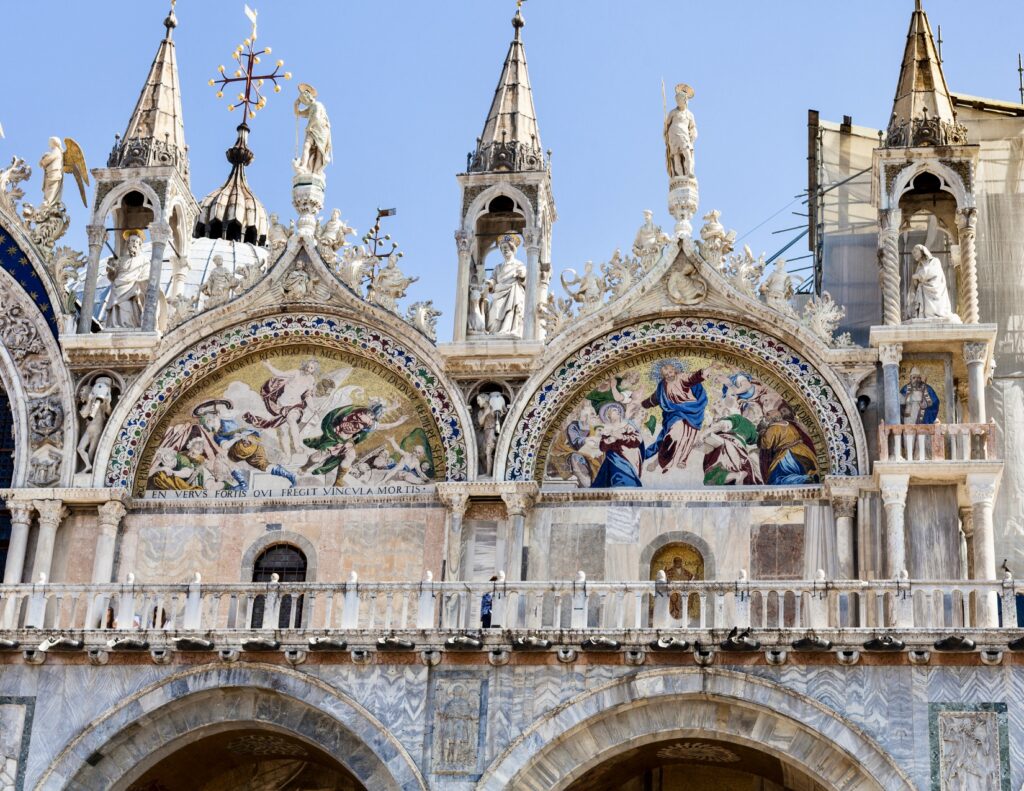
Pro Tips:
Large bags or rucksacks aren’t allowed in the basilica. So leave them at your accommodation. No professional photography is allowed inside either.
Mass:
The basilica is open for mass and private prayer from 7:00 am to 11:45 am and 5:00 pm to 7:30 pm. Entrance is from the Piazzetta dei Leoncini door.
Dress Code:
To maintain a respectful atmosphere, you should wear clothing that covers shoulders, knees, and midriffs. Sleeveless tops, tight leggings, short skirts, and short shorts may not be considered appropriate attire.
If you are visiting in summer and it is hot, bring something to cover your shoulders.
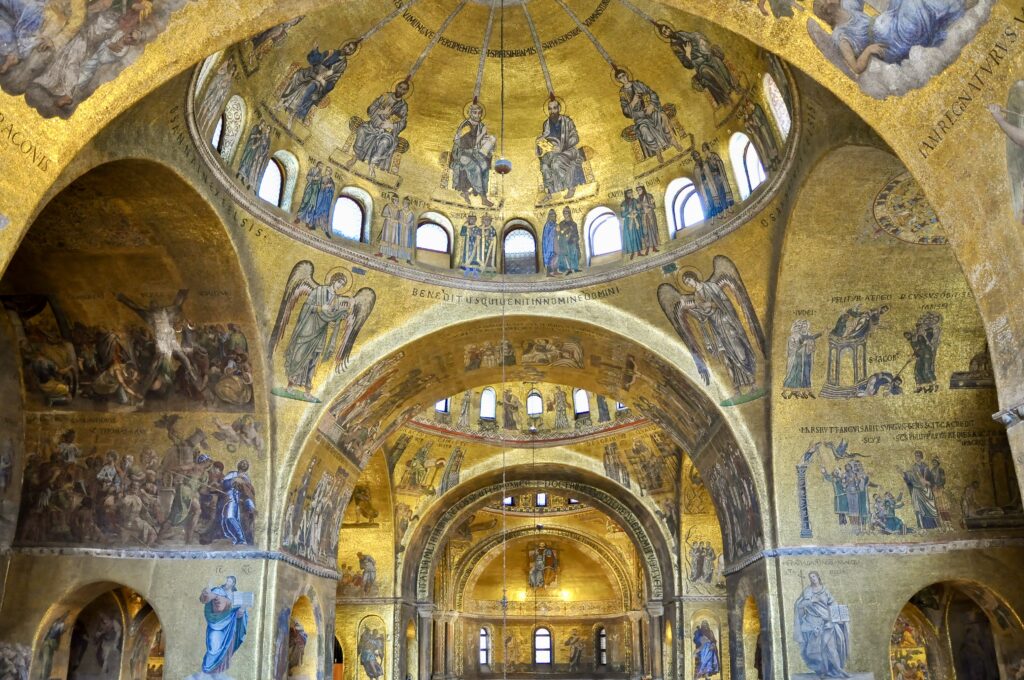
I hope you’ve enjoyed my guide to St. Mark’s Basilica. You may find these other Venice travel guides and resources useful:
- One day in Venice itinerary
- 2 days in Venice itinerary
- Guide to the Accademia Gallery
- Guide to the Doge’s Palace
- Top Attractions on the Grand Canal
- Guide to the Peggy Guggenheim Collection
- Venice art bucket list
- How many days to spend in Venice?
- 30+ tips for visiting Venice
- Guide to the Frari Church
If you need a guide to St. Mark’s Basilica, pin it for later.

